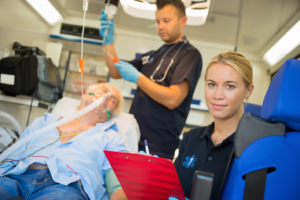
Carlo Castillo
Carlo is a Professional Health and Education Writer. He has built a career creating educational articles for both patients and healthcare professionals.
Knowing CPR or cardiopulmonary resuscitation is essential, especially when a cardiovascular emergency occurs at an out-of-hospital setting. According to the CDC, more than 350,000 out-of-hospital cardiac arrests occur each year. This startling statistic sheds light on why more people should value the importance of CPR. While cardiac arrest can’t be 100% prevented, you can help in mitigating the damage that it causes with the help of CPR.
Who Should Learn CPR?
A study was conducted among sixth-graders to check their capacity to utilize Hands-Only CPR for saving lives. Results showed that most of the children could perform CPR at the proper compression rate and in the right location. This study presented that sixth graders are viable to train for CPR and save lives. The American Heart Association has been dedicated to training the younger generation CPR in different school programs. Making CPR training a requirement before graduating from high school in 34 states is a big step towards awareness.
Easy to Learn
CPR is easy to learn, and doesn’t need to be intimidating. Even children should learn to perform CPR. While cardiopulmonary resuscitation requires chest compressions and rescue breaths, studies have shown that even younger populations have the capacity to learn and implement the algorithm effectively.
Surviving Cardiac Arrest
About 9 in 10 people who experience out-of-hospital cardiac arrest die. However, these odds can improve with the help of CPR, especially if performed at the onset of the emergency, within the first few minutes. CPR helps as it can double or even triple the chance of survival of a patient.
Who is at Greatest Risk of Cardiac Arrest?
People experiencing cardiac arrest who are in low-income, Hispanic, and Black neighborhoods are less likely to be helped by bystanders via CPR compared to people residing in white high-income neighborhoods.
In public places, women are less likely to get CPR upon a cardiac arrest compared to men. As a community we can help change these outcomes and work towards providing care to everyone in need.
CPR in the United States
In the United States, out of the 400,000 or more who experience out-of-hospital cardiac arrest, just 6% get to survive the incident. The very low percentage might be linked to the stat that just 3% of Americans study or train about CPR each year.
A report from the National Academy of Medicine has shown that a few communities have already improved survival against cardiac arrest. The city of Seattle is a great example as the community showcased cardiac arrest response improvement on training more bystanders and the effectiveness of first responders. The survival rate of Seattle’s out-of-hospital cardiac arrest has already surpassed 60%. In many urban areas in the country, the rates are only in the single digits.
Two key recommendations are being offered by the National Academy of Medicine: creating a nationwide cardiac arrest registry and improving programs in communities and schools to train more people in AED use and CPR.
How is Cardiopulmonary Resuscitation Performed?
There are two versions of CPR:
For trained professionals and healthcare providers: CPR via chest compressions and breathing mouth-to-mouth is at a 30:2 ratio of compressions-to-breaths. When it comes to adults experiencing cardiac arrest, rescuers can perform 100 to 120/min of chest compressions and a depth of a minimum of 2 inches.
For bystanders or the general public witnessing an adult cardiac arrest, Hand-Only CPR or compression-only CPR is acceptable. There are no mouth-to-mouth breaths with Hand-only CPR. This is a recommended method when people see someone collapse in a setting outside of the hospital.
To be effective in helping someone experiencing a cardiac arrest, the important words to remember are “recognize” and “respond.”
Recognize
A lot of people still can’t tell the difference between a heart attack, a cardiac arrest, or a fainting spell. It is essential to note that someone experiencing cardiac arrest does not have a pulse, does not breathe, and cannot respond. A person experiencing a heart attack may still be breathing, conscious, have a pulse, and can respond.
Respond
If you can recognize a cardiac arrest, here are the things that you should immediately do:
Give 911 a call as soon as possible or let someone else call for you while you attend to the patient. That call is very critical as it would only be the start of the waiting time until emergency medical responders arrive. They are needed as fast as possible because they have the equipment and the capability to rush the patient to the ER immediately.
Start performing hands-only chest compressions:
Place one of your hands over the other then put them both on the breastbone of the patient. Make sure your hands are on the middle part of the victim’s chest.
Press hard so that the chest moves inward about one inch.
Relax then repeat. Perform this 100 times in a minute. To get the right tempo, the Bee Gees’ “Stayin Alive” song should guide you.
Continue performing CPR until emergency responders arrive with an AED.
Top Reasons to Learn CPR
Below are the top reasons why you should learn cardiopulmonary resuscitation as soon as possible.
Save Lives
This is the top reason why you should learn CPR. Being a lifesaver can be as rewarding as it gets. Knowing even just the basics can prove very helpful in circulating the blood while waiting for emergency medical responders to arrive. Having enough knowledge about CPR can be very critical during cardiac arrest emergencies as these may happen at home, at work, or just about anywhere outside of a hospital.
You can offer that crucial help when an emergency happens in front of you. You don’t have to just wait, hope, and pray that someone knows CPR because you can be the one who saves that person’s life.
Around 90% of people die when experiencing cardiac arrest outside of hospitals. You can be a lifesaver to these people. Cardiopulmonary resuscitation helps in doubling or even tripling people’s chances of surviving cardiac arrest when immediately performed. Those who aim to learn more about saving lives are highly recommended to study Basic Life Support (BLS) and learn about the comprehensive BLS algorithms.
Be Your Family’s Potential First Responder
Of the 350,000 cardiac arrests that happen outside of the hospital each year, seven out of ten happen at home. A cardiac arrest may seem typical for older or sick people but it can strike anyone even at the most unexpected times. There is no 100% chance of avoiding the condition.
Knowing how to perform CPR gives your family member a fighting chance to live. By being trained in performing CPR, you have the most efficient opportunity to buy time while waiting for an ambulance to arrive. Time is crucial in cardiac emergencies and your CPR capability can help influence the outcome of your family member’s situation.
Prevent Brain Death
The pumping of the heart stops upon cardiac arrest. As a result, the body fails to acquire the blood flow that it needs. This is a critical emergency because blood contains oxygen that the different parts of the body need to work properly.
One of the most important organs that require blood is the brain. A cardiac arrest prevents the brain from receiving oxygen and the cells inside will start dying. Within as quick as 5 minutes, brain death may occur. As soon as this happens, some functions of the brain may be lost permanently. CPR serves a very important purpose because it helps prolong the time it takes for brain death.
During the act of chest compression, you help by being a substitute for the beating function of the heart. Even though it is not 100% as effective as the heart itself, CPR can help in pumping both blood and oxygen to different vital organs such as the brain.
Get an Added Advantage In The Workplace
For those who plan on applying as a nanny, a babysitter, or as a teacher to young children, listing CPR training on your resume offers an added advantage over other people applying for the position. Your critical lifesaving skills can provide parents or guardians better peace of mind when they choose to leave their children with you.
The Crucial Role of CPR
Learning CPR should already be a must for every person in the world as a cardiac arrest does not choose any race or nationality. Cardiac arrest may happen anytime and anywhere. Being able to have CPR training doubles or even triples the chance of survival. What is needed right now is to spread more awareness in many communities all over the world. CPR is easy to learn and you should take the time to learn it not just for yourself but also for your family’s sake.


